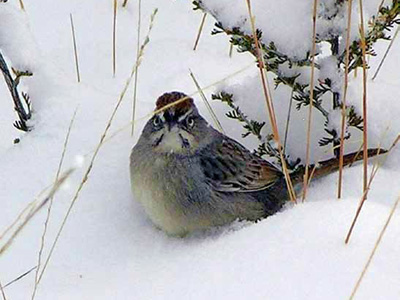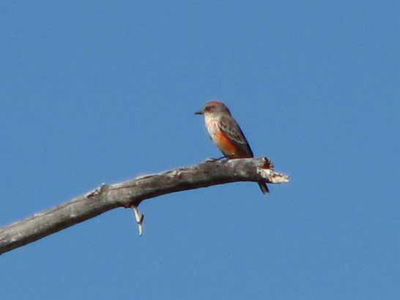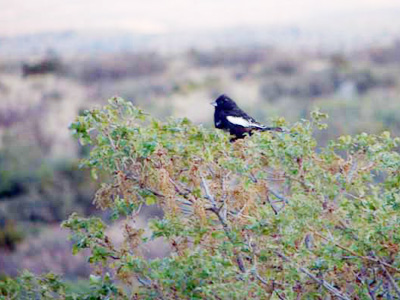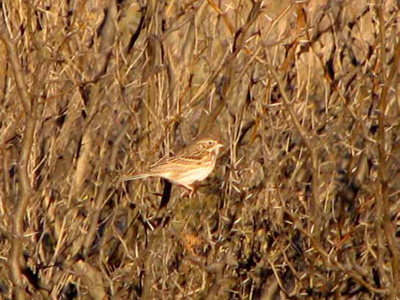In winter of 2002 and 2003, an independent researcher began conducting a two-year inventory of winter-resident birds in grasslands in two parks in the National Park Service’s Chihuahuan Desert Network.
The objective of this study was to inventory selected grassland habitats in Big Bend and Guadalupe Mountains national parks for the presence, diversity, and abundance of wintering bird species. The data from this study may be used to develop bird monitoring programs in the Chihuahuan Desert Network.
Methods

NPS
In 2002, the researcher delineated, examined, and evaluated the grassland habitats in Big Bend National Park (NP) and Guadalupe Mountains NP. Grassland habitats included areas with large and variable shrub components, including denuded areas (areas stripped of vegetation), which are typical of the Chihuahuan Desert. During this initial stage, the researcher worked with park staff and visited sites to locate representative examples of grassland habitat. Grassland habitats were grouped into broad, but definable and easily accessible habitat types.

Missy Powell / NPS
Big Bend National Park
A total of 13 transects representing four basic habitat types or aspects were established in Big Bend NP, ranging from 500 to 1,000 meters (1,640 to 3,280 ft), totaling 8,500 meters (27,900 ft). Transects were run three times each during the 2002–03 and 2003–04 field seasons. Three transects were established in tobosa grasslands (North Rosillos, Bone Springs Draw, and fossil bone exhibit areas), riparian grasslands (Rio Grande Village, Black Dike area, and Castolon area), and Chisos foothills grasslands (Cattail Falls parking area, mile marker 3 west area, and mile marker 4 east area), and four transects were established in lower desert grasslands (Tornillo Flats, Burro Mesa area, Maverick Road area, and mile marker 16 west area).
Guadalupe Mountains National Park
In Guadalupe Mountains NP, a total of nine transects representing four basic habitat types or aspects were established, ranging from 300 to 1,000 meters (985 to 3,280 ft), totaling 5,500 meters (18,044 ft). Transects were run three times each during the 2002–03 and 2003–04 field seasons. Three transects were established in the sacaton grasslands (sacaton flat area, mesquite invaded, and degraded sacaton) and two transects were established in the Dog Canyon grasslands (Bush Mountain Trail and Indian Meadow areas), western foothills (Yucca #1 and Yucca #2, both near the Williams Ranch Road), and eastern foothills (east of residential area and Frijole road area). Every site at both parks were photographed and recorded with a Global Positioning System (GPS) unit.
Birds detected along each transect line were counted, identified and categorized as either within 15 m (50 ft) of either side of the line or beyond 15 meters (50 ft). Visual and audible detections were recorded if the species was positively identified. After walking the transect line in one direction, the researcher collected data on the return trip by weaving back and forth across the transect line in an “S” formation to detect additional species or to relocate individuals from the first run to confirm their identification. New detections were considered “exit” observations. When possible, data were collected in the morning. Weather conditions and winter season bird activities occasionally delayed data collection until mid-day.
During the 2003–04 field season, the researcher collected basic habitat data to be used to analyze plant species composition and relative abundance. The data collection technique did not produce quantitative data on the various plants found along each transect, but did provide some information about the structure and composition of the habitat. Only woody, identifiable semi-woody plants, and grass species were recorded during this effort. Many plant species were dormant at the time of the survey and were difficult to identify. Specimens were collected to verify identity. Basic vegetation was analyzed for each transect site.
Results

© Jeremy Markuson
Bird Sampling
Big Bend National Park
A total of 2,844 birds of 73 species were recorded during 78 transect runs in Big Bend NP. The highest number of species in the park was recorded in the riparian grassland habitat type at Rio Grande Village. The highest number of individual birds recorded at single habitat type was 588 in the lower desert grasslands at the Burro Mesa transect site. Both the lowest number of species and individuals observed were in the lower desert grasslands habitat type in the Tornillo Flats area.
Thirteen species were common to all four habitat types: greater roadrunner (Geococcyx californianus), Say’s phoebe (Sayornis saya), loggerhead shrike (Lanius ludovicianus), common raven (Corvus corax), Bewick’s wren (Thryomanes bewickii), northern mockingbird (Mimus polyglottos), greentailed towhee (Pipilo chlorurus), Cassin’s sparrow (Aimophila cassinii), Brewer’s sparrow (Spizella breweri), black-throated sparrow (Amphispiza bilineata), white-crowned sparrow (Zonotrichia leucophrys), Pyrrhuloxia (Cardinalis sinuatus), and house finch (Carpodacus mexicanus). Some species were uniquely recorded in three habitat types: 5 in tobosa grasslands, 25 in riparian grasslands, and 4 in Chisos foothills grasslands.
Guadalupe Mountains National Park
A total of 495 birds of 39 species were recorded during 54 transect runs in Guadalupe Mountains NP. The highest number of species in the park was recorded in the Dog Canyon grasslands on the Indian Meadow transect. The highest number of individual birds recorded for a single habitat type was 166, also in the Dog Canyon grasslands on the Bush Mountain Trail transect. Both the lowest number of species and individuals recorded were in the degraded sacaton grassland habitat southwest of the Gypsum Dunes. Only two bird species were common to all four habitat types: Bewick’s wren (Thryomanes bewickii) and house finch (Carpodacus mexicanus). Species were uniquely recorded in each habitat type: five in sacaton grasslands, eight in Dog Canyon area grasslands, three in the western foothills habitat type, and five in the eastern foothills.
Vegetation Sampling
Big Bend National Park
In 2003–04, 42 species of woody plants and 43 species of grasses were documented at the transect sites in Big Bend NP. The highest diversity of both woody and grass species were recorded in the Chisos foothills habitat type near Panther Junction. Only five woody species were recorded within all four habitat types and only three grass species were found in all four habitats. No woody species were uniquely recorded in tobosa grassland habitat, though all other habitats contained unique observations of woody and grass species.
Guadalupe Mountains National Park
In 2003–04, 47 species of woody plants and 29 species of grasses were documented at the transect sites in Guadalupe Mountains NP. The highest diversity of woody species was recorded in the western foothills on the Yucca #2 transect and the highest diversity for grasses was in Dog Canyon.
Only one woody species was recorded within all four habitat types, the soaptree yucca (Carpodacus mexicanus). No grass species were recorded in all four habitat types. Woody species were uniquely recorded in each habitat type: 3 in sacaton grasslands, 4 in Dog Canyon area grasslands, 10 in the western foothills habitat type, and 11 in the eastern foothills. Grass species were uniquely recorded in three habitat types: 2 in sacaton grasslands, 13 in Dog Canyon area grasslands, and 9 in the eastern foothills.
Discussion

NPS
Bird populations in the Chihuahuan Desert, particularly winter residents, are typically highly dynamic. This may be related to precipitation derived from monsoons or summer rains.
Big Bend National Park
In general, birds were more abundant in Big Bend NP in 2002–03 than in 2003–04 and may be an example of the dynamic bird population. Nearly all sparrow species were more abundant in 2002–03 than in 2003–04. The Brewer’s sparrow, a winter-resident species in Big Bend NP, was observed in 2002–03 but not in 2003–04. The black-throated sparrow, a permanent resident in the park, was also more abundant in 2002–03 than in 2003–04.
Changes in abundance also occurred with the scaled quail (Callipepla squamata), which were abundant in summer of 2003 though only 12 individuals were detected in winter 2002–03 and 219 individuals were detected in 2003–04. In 2002–03, 17 sage thrasher (Oreoscoptes montanus) individuals, a species which exhibits normal patterns of sudden increases in population when natural checks and balances are altered, were observed while only 1 individual was documented in 2003–04. One riparian grassland site in Big Bend NP was in the process of being restored. It may be necessary to reevaluate the vegetation composition in the survey areas for future winter-resident grassland bird surveys.
Guadalupe Mountains National Park
In Guadalupe Mountains NP, birds were more abundant in 2003–04 than in 2002–03, primarily due to a greater abundance in Dog Canyon in the second season. Only seven species of sparrows were recorded in Guadalupe Mountains NP.
It appears that most, if not all, grasslands in Guadalupe Mountains NP are more important to a greater number of bird species during migration than during winter. With the exception of the sacaton grasslands in the dunes area of the park, it appears that winter-resident species prefer the woody habitat components than the grassland components. The low diversity of birds in the sacaton grasslands on the west side of the park may be related to the low density and diversity of grass, both of which can be related to overgrazing and the effects of drought. The grasslands in the Dog Canyon area were more diverse than expected and bird species diversity was also greater here.
The grassland habitats and Gypsum Dunes area were under habitat manipulation and management during this study, primarily restoration. Both the Frijole Road and residential area transects were in areas that had recently undergone a prescribed fire. It is possible that bird species and abundance in this area can change as the grasslands have more time to recover. It may be necessary to reevaluate the vegetation composition in the survey areas for future winter-resident grassland birds surveys.
Literature Cited
Bryan, K.B. 2007. A survey of winter-resident grassland birds in Big Bend and Guadalupe Mountains National Parks.
Project Contacts
Kelly Bryan, Fort Davis, TX, USA, kelly.b.bryan@gmail.com
Prepared by Emily Yost, Chihuahuan Desert Network Inventory and Monitoring Program, 2009.
Last updated: July 23, 2015
